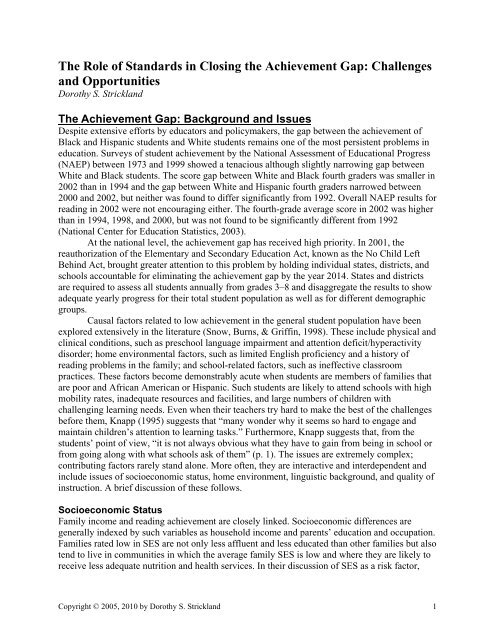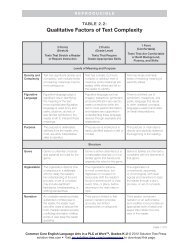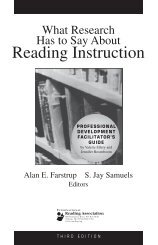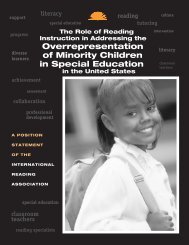Dorothy Strickland - International Reading Association
Dorothy Strickland - International Reading Association
Dorothy Strickland - International Reading Association
You also want an ePaper? Increase the reach of your titles
YUMPU automatically turns print PDFs into web optimized ePapers that Google loves.
The Role of Standards in Closing the Achievement Gap: Challenges<br />
and Opportunities<br />
<strong>Dorothy</strong> S. <strong>Strickland</strong><br />
The Achievement Gap: Background and Issues<br />
Despite extensive efforts by educators and policymakers, the gap between the achievement of<br />
Black and Hispanic students and White students remains one of the most persistent problems in<br />
education. Surveys of student achievement by the National Assessment of Educational Progress<br />
(NAEP) between 1973 and 1999 showed a tenacious although slightly narrowing gap between<br />
White and Black students. The score gap between White and Black fourth graders was smaller in<br />
2002 than in 1994 and the gap between White and Hispanic fourth graders narrowed between<br />
2000 and 2002, but neither was found to differ significantly from 1992. Overall NAEP results for<br />
reading in 2002 were not encouraging either. The fourth-grade average score in 2002 was higher<br />
than in 1994, 1998, and 2000, but was not found to be significantly different from 1992<br />
(National Center for Education Statistics, 2003).<br />
At the national level, the achievement gap has received high priority. In 2001, the<br />
reauthorization of the Elementary and Secondary Education Act, known as the No Child Left<br />
Behind Act, brought greater attention to this problem by holding individual states, districts, and<br />
schools accountable for eliminating the achievement gap by the year 2014. States and districts<br />
are required to assess all students annually from grades 3–8 and disaggregate the results to show<br />
adequate yearly progress for their total student population as well as for different demographic<br />
groups.<br />
Causal factors related to low achievement in the general student population have been<br />
explored extensively in the literature (Snow, Burns, & Griffin, 1998). These include physical and<br />
clinical conditions, such as preschool language impairment and attention deficit/hyperactivity<br />
disorder; home environmental factors, such as limited English proficiency and a history of<br />
reading problems in the family; and school-related factors, such as ineffective classroom<br />
practices. These factors become demonstrably acute when students are members of families that<br />
are poor and African American or Hispanic. Such students are likely to attend schools with high<br />
mobility rates, inadequate resources and facilities, and large numbers of children with<br />
challenging learning needs. Even when their teachers try hard to make the best of the challenges<br />
before them, Knapp (1995) suggests that “many wonder why it seems so hard to engage and<br />
maintain children’s attention to learning tasks.” Furthermore, Knapp suggests that, from the<br />
students’ point of view, “it is not always obvious what they have to gain from being in school or<br />
from going along with what schools ask of them” (p. 1). The issues are extremely complex;<br />
contributing factors rarely stand alone. More often, they are interactive and interdependent and<br />
include issues of socioeconomic status, home environment, linguistic background, and quality of<br />
instruction. A brief discussion of these follows.<br />
Socioeconomic Status<br />
Family income and reading achievement are closely linked. Socioeconomic differences are<br />
generally indexed by such variables as household income and parents’ education and occupation.<br />
Families rated low in SES are not only less affluent and less educated than other families but also<br />
tend to live in communities in which the average family SES is low and where they are likely to<br />
receive less adequate nutrition and health services. In their discussion of SES as a risk factor,<br />
Copyright © 2005, 2010 by <strong>Dorothy</strong> S. <strong>Strickland</strong> 1
Snow, Burns, and Griffin (1998) describe low SES as both an individual risk factor and a group<br />
risk factor. A low-status child in a generally moderate or upper-status school or community is far<br />
less at risk than that same child in a whole school or community of low-status children (p. 124).<br />
School funding plays an important role in the socioeconomic status of schools and<br />
communities. Recent studies have reanalyzed the research on school funding and its influence on<br />
the SES of schools and school districts. Biddle and Berliner (2003) analyzed the average annual<br />
expenditures per student for each of the United States and the variation among districts in total<br />
revenues per student within each state. They found that while the disparities in funding differ<br />
sharply among the states, they were greater within some states than among the states as a group.<br />
Unlike the Coleman Report (1972), which reported that school quality (and level of school<br />
funding) had little-to-no impact once home and peer factors were taken into account, Biddle and<br />
Berliner state that funding inequities do make a difference (p. 8).<br />
Home Environment<br />
Even before children enter kindergarten, the achievement gap is in place. The U.S. Department<br />
of Education’s Early Childhood Longitudinal Study (ECLS-K; 2000) shows that by the time<br />
children are five years old, there is a gap in school-related skills and knowledge between African<br />
American and European American children, even when their mothers have equal years of<br />
schooling (it is important to keep in mind that the quality of the mothers’ schooling is not<br />
factored into these measures). Phillips (2000) analyzed several gap-related surveys in an attempt<br />
to describe age-related changes in the Black-White gap as children move through the grades:<br />
Taken together, we estimate that at least half of the black-white gap that exists at the end of<br />
twelfth grade can be attributed to the gap that already existed at the beginning of first grade. The<br />
remainder of the gap seems to emerge during the school years. (p. 136)<br />
Although little is known about the child-rearing practices that may affect children’s<br />
school performance during the upper elementary years and beyond, it may be safe to say that<br />
differences (not deficits) in child-rearing practices may contribute to the gap. Explanations such<br />
as that offered by Ogbu (2002) attribute much of the problem to Black youth cultural patterns<br />
and behaviors that are counterproductive for academic success. Other researchers dispute this<br />
conclusion. Ferguson (2002) speculates that what Ogbu observed was “a clumsy attempt by<br />
black students to search for a comfortable racial identity.” Indeed, as preadolescent and<br />
adolescent students attempt to find their place in society, their personal goals and behaviors often<br />
diverge from what the school expects and demands. When these students come from cultural<br />
backgrounds that differ greatly from that of the school, their attempts to “find their place” may<br />
put them at risk of missing out on important educational experiences offered by schools and<br />
society.<br />
Linguistic Background<br />
The low achievement of poor African American and Hispanic children has often been associated<br />
with their dialect or language. During the 1960s, linguists looked closely at language diversity as<br />
a cause of school failure. Those studies revealed key principles of language learning that remain<br />
helpful to teachers and curriculum developers: All language varieties are equally valid; all<br />
language varieties can accommodate all levels of thought; and any variety of standard English is<br />
not intrinsically better than any nonstandard dialect (Gopaul-McNicol, Reid, & Wisdom, 1998,<br />
p. 7). Similarly, research in the language development of children for whom English is a second<br />
Copyright © 2005, 2010 by <strong>Dorothy</strong> S. <strong>Strickland</strong> 2
language supports the belief that the learner’s home language should be valued and accepted as<br />
part of second language acquisition and learning.<br />
This does not deny the fact that the form language takes has economic, social, and<br />
political importance. Nor does it suggest that helping students achieve competence in Standard<br />
English is not an important goal of the school. It does suggest that much of the low achievement<br />
of language-minority students may be pedagogically induced or exacerbated and therefore<br />
amenable to change (Rueda, 1991). Perhaps most important is the need to keep in mind that all<br />
children learn the language to which they have been exposed. The tendency to equate the use of<br />
language other than Standard English with incompetence must be resisted (<strong>Strickland</strong>, Ganske, &<br />
Monroe, 2002).<br />
The intermediate grades provide an excellent time to guide children in an exploration of<br />
various languages and dialects. Preadolescent children are capable of comparing and contrasting<br />
various ways to express ideas, both orally and in writing. They can also begin to make judgments<br />
about when certain forms of language may be more appropriate than others. Expanding<br />
children’s language repertoires to accommodate a wider range of situations and linguistic<br />
capability should be the ultimate goal.<br />
Quality of Instruction<br />
Many researchers have turned their attention to what is increasingly considered to be a key factor<br />
contributing to the achievement gap—the differences in the quality of instruction that students<br />
receive. According to Haycock (2001), rather than focus on poverty and parental education, we<br />
should begin to concentrate on what takes place in the classrooms that minority students attend.<br />
The problems listed by Haycock include the following: students in high-poverty and highminority<br />
schools are not being challenged; minority students are placed in low-level classes with<br />
a curriculum that does not prepare them for college; no provision is made for students who<br />
require more time and instruction to get on grade level; teachers are often not qualified in the<br />
subjects that they teach; schools with 90 percent greater enrollment or minority students have a<br />
high percentage of underqualified teachers than predominantly White schools. Other researchers<br />
(Darling-Hammond & Hudson, 1989; Ferguson & Brown, 1998) have linked teacher quality with<br />
student achievement and called for a look at both teacher quality, and teaching quality.<br />
The Achievement Gap and Standards<br />
All too often, educators tend to deal with complicated problems by rank-ordering the issues and<br />
dealing with them one at a time. The failure to close the achievement gap may be telling us that<br />
such a linear approach is not the best strategy for addressing the achievement gap (Singham,<br />
2003). Indeed, the value of standards, as a critical element in closing the achievement gap, must<br />
be viewed as one important part of a complex web of possible solutions. Following are several<br />
ways that standards can positively influence schools where students are low achievers.<br />
Promoting a Shared Vision<br />
Stability and sense of mission is important in any school community. It is often missing in low-<br />
SES schools. The process of setting standards or aligning local standards with existing state or<br />
nationally generated standards can inspire teachers and administrators to seriously consider their<br />
goals and commitments to students. Viewing standards as part of an overall mission statement<br />
can provide new teachers with a better sense of what the school expects from them and what they<br />
should expect from students. Teachers who have grown accustomed to teaching particular<br />
Copyright © 2005, 2010 by <strong>Dorothy</strong> S. <strong>Strickland</strong> 3
content in set ways may have to rethink what and how they teach. In situations where the teacher<br />
turnover is great, this is particularly important, though it will take time and it may produce a<br />
degree of anxiety for some. Mentor teachers and literacy facilitators, whose job it is to assimilate<br />
new staff into the system, can use the standards as a springboard for discussing a variety of<br />
curriculum and instructional issues.<br />
Creating a More Focused and Coherent Curriculum<br />
Student mobility, even within the same school district, is often a key deterrent to student<br />
achievement. Standards can provide the impetus for schoolwide curriculum reform. While a rigid<br />
curriculum is not desirable, some degree of curricular consistency within a school and across<br />
schools within a district is helpful for students and teachers alike. The creation and<br />
implementation of a thoughtfully crafted and consistent set of standards can motivate faculty and<br />
administrators to take a serious look at the existing curriculum—a realistic look at what students<br />
need to know and what they bring to the task and the existing disparities that need attention.<br />
Having a well-constructed and well-understood set of standards can provide the credible<br />
evidence for needed resources and planning for professional development.<br />
Linking to Levels of Performance and Assessment<br />
Setting high, yet realistic, goals for students is a constant concern in settings where there is<br />
chronic student failure. Schools with low achievement are frequently told that their expectations<br />
are too low. Standards can be used to go beyond stating what children should learn and be able to<br />
do. They can set levels of performance, which can be adjusted at the district and school levels, if<br />
necessary. Schools can use standards to set benchmarks for “how good is good enough” at<br />
various critical points in a student’s development. Mechanisms for monitoring student growth<br />
can be put in place with provisions for intervention for students and for the professional<br />
development of teachers. Teachers need not lower their expectations. On the contrary, they and<br />
their students must have a clear sense of what is expected and then use instructionally<br />
appropriate practices to move from present levels of performance toward increasingly higher<br />
goals.<br />
Linking standards with assessment is important but may have unintended consequences<br />
in low-performing schools. Schools where academic achievement is low are under great pressure<br />
to raise test scores. High standards and test performance are often equated, resulting in large<br />
amounts of instructional time devoted to teaching directly to summative standardized<br />
evaluations. Using standards to teach to the underlying skills and strategies required to meet<br />
them provides the assessment link that is most likely to ensure better teaching and learning.<br />
Links should be made to ongoing, formative teacher assessment and student self-assessment in<br />
the classroom, rather than summative evaluation.<br />
Planning and Implementing Long-Term Professional Development<br />
Both teacher quality and teaching quality are critical issues in schools where students are not<br />
achieving well. These schools are likely to have more beginning teachers or teachers who are not<br />
certified to teach in the area to which they are assigned. The creation and implementation of<br />
standards can be the springboard for a program of “ongoing” professional development at the<br />
district and school levels. This kind of professional development can have effects beyond that of<br />
upgrading teacher skills to provide a supportive professional atmosphere in which teachers are<br />
more likely to choose to remain in a difficult school.<br />
Copyright © 2005, 2010 by <strong>Dorothy</strong> S. <strong>Strickland</strong> 4
Making the Case for Needed Resources<br />
The lack of adequate resources is frequently presented as a major cause of the achievement gap.<br />
The wide disparity in school funding across and within states has already been discussed.<br />
Standards have the potential to encourage states and districts to provide resources needed for<br />
students to meet them. The case to be made must go beyond setting standards, however, to<br />
include teachers’ and administrators’ understanding and active use of them to promote student<br />
achievement. This can provide the basis for a persuasive argument to school boards and<br />
legislative bodies.<br />
Opportunities and Challenges<br />
Used wisely, standards provide an opportunity to be a catalyst for change in schools where<br />
students are performing poorly. Yet, standards are only one part of the equation. The context in<br />
which they are implemented can make a huge difference. Standards are meant to address<br />
students’ cognitive development. They can provide a framework for quality instruction.<br />
However, it is unlikely that they will have an impact unless the school environment is<br />
emotionally safe and unless there is a sense of community. For preadolescents, how instruction is<br />
delivered may be as important as what is delivered. The intermediate grades may be the last<br />
opportunity for some children to become engaged with schooling. Indeed, many are already<br />
beginning to drop out intellectually, if not physically. For standards to serve intermediate<br />
children well, they must be framed and implemented with the broader framework of instruction<br />
in mind. Fourth and fifth graders need environments that nurture all the pathways by which they<br />
learn.<br />
References<br />
Biddle, B.J., & Berliner, D.C. (2003). What research says about unequal funding for schools in<br />
America: Policy perspectives. San Francisco, CA: WestEd.<br />
Coleman, J.S. (1972). The evaluation of equality of educational opportunity. In F. Mosteller &<br />
D.P. Moynihan (Eds.), On equality of educational opportunity: Papers deriving from the<br />
Harvard University Faculty Seminar on the Coleman Report (pp. 146–167). New York:<br />
Vintage Books.<br />
Darling-Hammond, L., & Hudson, L. (1989). Teachers and teaching. In R.J. Shavelson, L.M.<br />
McDonnell, & J. Oakes (Eds.), Indicators for monitoring mathematics and science<br />
education. Santa Monica, CA: The Rand Corporation.<br />
Early Childhood Longitudinal Study (ECLS-K). (2000). Washington, DC: U.S. Department of<br />
Education Office of Educational Research and Improvement.<br />
Ferguson, R.F. (2002, November 30) as reported in The New York Times, p. B11.<br />
Ferguson, R.F., & Brown, J. (1998). Certification test scores, teacher quality, and student<br />
achievement. Paper presented at the Analytic Issues in the Assessment of Student<br />
Achievement conference sponsored by the National Center for Education Statistics,<br />
Washington, DC.<br />
Gopaul-McNicol, S., Reid, S., & Wisdom, G. (1998). The psychoeducational assessment of<br />
Ebonics speakers: Issues and challenges. The Journal of Negro Education, 67, 16–24.<br />
doi:10.2307/2668236<br />
Haycock, K. (2001). Closing the achievement gap. Educational Leadership, 58(6), 6–11.<br />
Copyright © 2005, 2010 by <strong>Dorothy</strong> S. <strong>Strickland</strong> 5
Knapp, M.S. (1995). Teaching for meaning in high-poverty classrooms. New York: Teachers<br />
College Press.<br />
National Center for Education Statistics. (2003). The nation’s report card: <strong>Reading</strong> highlights<br />
2002. Washington, DC: U.S. Department of Education.<br />
No Child Left Behind Act of 2001, Pub. L. No. 107–110, 115 Stat. 1425 (2002).<br />
Ogbu, J.U. (2002, November 30) as reported in The New York Times, p. B11.<br />
Phillips, M. (2000). Understanding ethnic differences in ethnic achievement: Empirical lessons<br />
from national data. In D.W. Grissmer & J.M. Ross (Eds.), Analytic issues in the<br />
assessment of student achievement. Washington, DC: National Center for Education<br />
Statistics.<br />
Rueda, R. (1991). Characteristics of literacy programs for language-minority students. In E.H.<br />
Hiebert (Ed.), Literacy for a diverse society: Perspectives, practices, and policies. New<br />
York: Teachers College Press.<br />
Singham, M. (2003). The achievement gap: Myths and reality. Phi Delta Kappan, 84, 586–591.<br />
Snow, C.E., Burns, M.S., & Griffin, P. (1998). Preventing reading difficulties in young children.<br />
Washington, DC: National Academy Press.<br />
<strong>Strickland</strong>, D.S., Ganske, K., & Monroe, J.K. (2002). Supporting struggling readers and writers:<br />
Strategies for classroom intervention 3–6. Portland, ME: Stenhouse; Newark, DE:<br />
<strong>International</strong> <strong>Reading</strong> <strong>Association</strong>.<br />
Copyright © 2005, 2010 by <strong>Dorothy</strong> S. <strong>Strickland</strong> 6
















